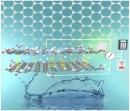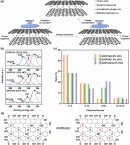An Australian company thinks there’s energy in the air that can be harvested to power things. Its self-charging battery concept called “energy ink” will enter a new phase this year. Its charge capabilities will increase from the milliampere-hour range into the ampere-hours.
It sounds like science fiction today, but we’re not very far from the moment when the batteries will be able to charge themselves from thin air. Strategic Elements is an Australian company working with the University of South Wales (UNSW) to develop a flexible, self-charging battery that can harvest electrical energy from the moisture in the air.
For now, the battery concept can only generate a small amount of electricity, which makes it more suitable for powering wearables and IoT gadgets. It already offers enough power for most existing wearable devices, which would never need to be put on a charger. Strategic Elements expects to have a working prototype by the end of the year. They also want to scale the Energy Ink battery to generate more energy in the range of a current power bank (4,000-10,000 mAh).
“It wasn’t long ago that many said it was impossible to produce any usable energy from moisture,” said an unnamed company representative in an ASX regulatory release. “For us to now realistically target the ampere-hour range generation of electrical energy solely from humidity in the air is a huge achievement. Our technology doesn’t rely on rare materials and carries no safety risks, and in addition, it can provide flexibility to electronics.”
There are few details on the new technology on the Strategic Elements website. Still, we can learn more from a recent study called “Boosting moisture-induced electricity generation from graphene oxide through engineering oxygen-based functional groups.” The study was published in the peer-reviewed journal Nano Energy and was authored by a team mainly from the UNSW’s Materials Science and Engineering. One of the authors is Dr. Dewei Chu, who Strategic Elements mentions as the team’s leader it’s working with.
According to the study, a pair of electrodes are attached to a hydrophilic “functional layer” of graphene oxide. When there’s a significant humidity gradient between the two sides of the device, one side starts absorbing water molecules from the air, ionizing them in the process. This puts in motion a process that frees up positively-charged hydrogen ions or hydrons.
Since there’s a higher concentration of hydrons on the moist side of the functional layer than on the dry side, they migrate towards the dry side. This generates a voltage at the electrodes. It’s not much, as the team only achieved a maximum of 0.85 V and 92.8 microamperes per square centimeter (0.155 sq-in), the highest values reported so far.
The good thing is these units can be connected to multiply their output without any loss. Strategic Elements already has a moisture battery pack that measures around 36 square cm (~6 sq in). The company will attempt to manufacture a test unit at 100 sq cm (15.5 sq in) in the coming months. The moment when this type of battery will be able to power electronic devices directly is not far, negating the need for a charger.
For now, the battery concept can only generate a small amount of electricity, which makes it more suitable for powering wearables and IoT gadgets. It already offers enough power for most existing wearable devices, which would never need to be put on a charger. Strategic Elements expects to have a working prototype by the end of the year. They also want to scale the Energy Ink battery to generate more energy in the range of a current power bank (4,000-10,000 mAh).
“It wasn’t long ago that many said it was impossible to produce any usable energy from moisture,” said an unnamed company representative in an ASX regulatory release. “For us to now realistically target the ampere-hour range generation of electrical energy solely from humidity in the air is a huge achievement. Our technology doesn’t rely on rare materials and carries no safety risks, and in addition, it can provide flexibility to electronics.”
There are few details on the new technology on the Strategic Elements website. Still, we can learn more from a recent study called “Boosting moisture-induced electricity generation from graphene oxide through engineering oxygen-based functional groups.” The study was published in the peer-reviewed journal Nano Energy and was authored by a team mainly from the UNSW’s Materials Science and Engineering. One of the authors is Dr. Dewei Chu, who Strategic Elements mentions as the team’s leader it’s working with.
According to the study, a pair of electrodes are attached to a hydrophilic “functional layer” of graphene oxide. When there’s a significant humidity gradient between the two sides of the device, one side starts absorbing water molecules from the air, ionizing them in the process. This puts in motion a process that frees up positively-charged hydrogen ions or hydrons.
Since there’s a higher concentration of hydrons on the moist side of the functional layer than on the dry side, they migrate towards the dry side. This generates a voltage at the electrodes. It’s not much, as the team only achieved a maximum of 0.85 V and 92.8 microamperes per square centimeter (0.155 sq-in), the highest values reported so far.
The good thing is these units can be connected to multiply their output without any loss. Strategic Elements already has a moisture battery pack that measures around 36 square cm (~6 sq in). The company will attempt to manufacture a test unit at 100 sq cm (15.5 sq in) in the coming months. The moment when this type of battery will be able to power electronic devices directly is not far, negating the need for a charger.






